NASA’s Jim Bridenstine shoots for the moon and for Mars, vows to leave politics on Earth
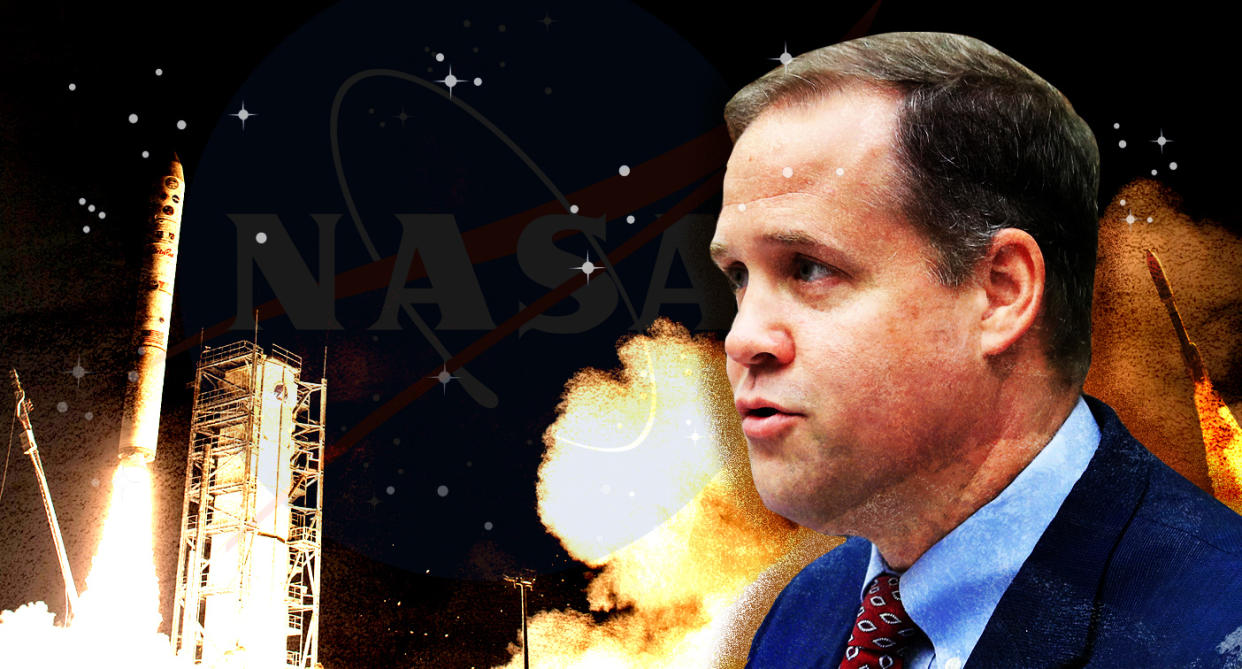
WASHINGTON — If you take the elevator to the ninth floor of NASA’s headquarters in Washington, you will find a long hallway with white walls and blue carpet, lined with portraits of previous administrators — constant reminders of the agency’s past triumphs and legacy. It leads to a reception area for the current administrator’s office, where the theme continues: A large picture of the International Space Station is flanked by the U.S. and NASA flags. But this stately scene is brought back down to earth by something all too terrestrial: the sound of CNN correspondents discussing Trump’s scandal du jour.
Jim Bridenstine, the 13th and current administrator of NASA, has been entrusted with stewarding one of America’s most cherished federal agencies through this hyperpartisan era. Despite a tumultuous confirmation process, his first two months at the helm have been smooth. He’s reconciled with Democrats who opposed him and has won the public support of groups advocating for space exploration.
At this point in NASA’s history, Bridenstine has the task of incorporating the private sector into the agency’s long-term missions — to establish a permanent presence on the moon and land an astronaut on Mars. I visited his office on June 20 to discuss his progress.
“If we’re going to go in a sustained way, it cannot be a United States government-exclusive mission. It has to be a mission that includes our commercial partners in this country and our international partners,” Bridenstine told Yahoo News. “We think that it is possible that as early as next year we could have a commercial company delivering something to the surface of the moon on behalf of NASA. That is an aggressive timeline, and I’m not guaranteeing it, but it’s what we’re shooting for.”
Since President Trump took office, the biggest change to NASA policy came on December 11 with the signing of Space Policy Directive 1, which calls on the administrator to lead “an innovative and sustainable program” with commercial and international partners to return to the moon to establish a base for eventual manned missions to Mars.
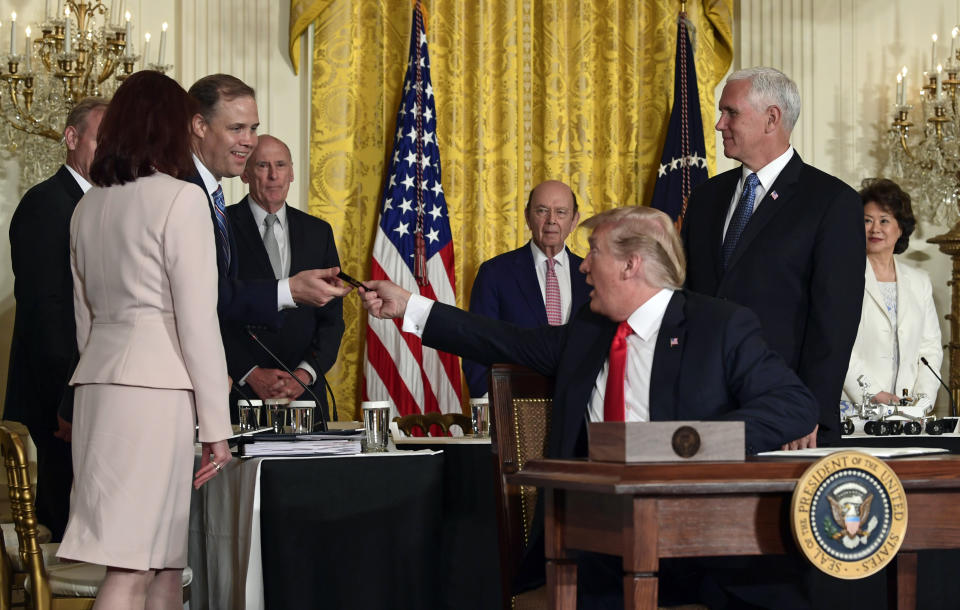
Shortly after Bridenstine arrived, NASA released a request for proposals from contractors to deliver small shipments to the moon, known as commercial lunar payload services (CLPS). Bridenstine said there could be as many as a dozen companies bidding for this opportunity.
“If one or more of those companies are successful, it’s a victory. And even if none of them are successful but we gain insights, knowledge and capabilities that are innovative that we can take advantage of, it’s still successful,” Bridenstine said.
From there, NASA will use those technologies to carry larger payloads, such as planetary rovers and robotic prospectors to dig for water ice and to excavate regolith, the loose rock and dust atop the moon’s bedrock, for lunar analysis and construction projects.
“Ultimately, we want to have landers that go to the moon with humans on board. The goal would be to do that within 10 years. I’m not guaranteeing anything, but that’s the objective, that’s the goal,” he said. It differs from the Apollo project because everything will be reusable and establish a sustainable architecture for return visits and further exploration.
“One of the challenges we had with Apollo is we left flags and footprints and after 1972 we never went back,” Bridenstine said.
I said it doesn’t sound too far out because NASA achieved President John F. Kennedy’s ambitious goal of sending an American to the moon before the end of the ‘60s. Bridenstine agreed and added that today’s NASA benefits from many things it didn’t have back then, including the commercial space industry’s more economical reusable rockets and miniaturized electronics. But there’s another side to this equation.
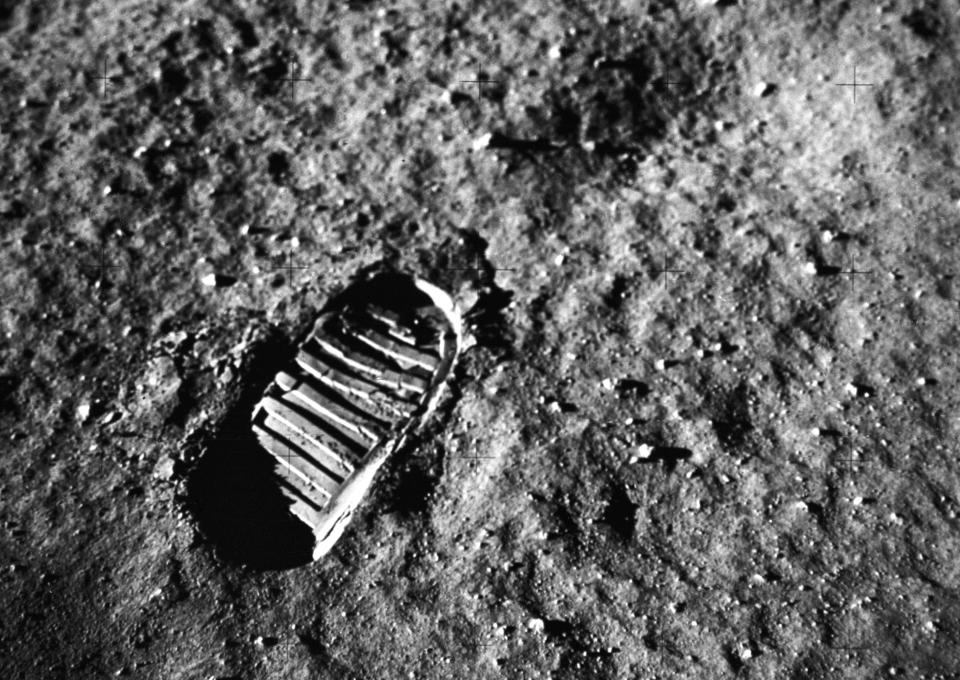
Today, NASA doesn’t receive the same slice of the federal budget it did during the agency’s glory days. For comparison, its share was more than four percent in the mid-1960s but only around 0.5 percent today. Bridenstine said budget constraints doomed earlier space initiatives, such as former President George H.W. Bush’s Space Exploration Initiative and former President George W. Bush’s Vision for Space Exploration.
The current NASA strategy of working with commercial and international partners takes this reality into account. The agency wants to build a sustainable fiscal model that will enable further exploration.
“That’s the vision here. We’re trying to accomplish the same objective, but we’re doing it in a way that’s never been done before,” he said.
Mark Hopkins, chairman of the executive committee for the National Space Society (NSS), a nonprofit advocacy group, said Bridenstine is in the somewhat difficult position of overseeing this transition toward a much more commercial approach to outer space and dealing with legacy aerospace corporations — such as Boeing or Lockheed Martin — in Washington, D.C. He said the space program, which has traditionally been dominated by government, is moving rapidly toward resembling the U.S. economy as a whole, run predominantly by private enterprise. Hopkins said demonstrations of lower-cost space transportation by companies like SpaceX and Blue Origin are revolutionizing the entire space program.
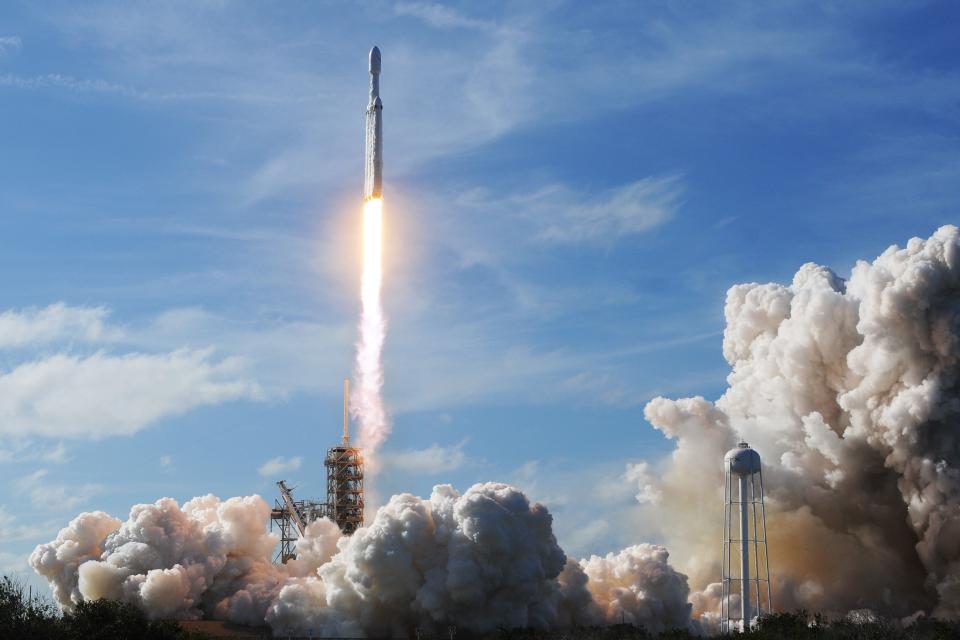
“How to integrate the capabilities of commercial space into NASA to take advantage of what the private sector is doing and promote the private sector when it’s doing a good job is critical at the current time, and that’s where Bridenstine is particularly adept,” Hopkins told Yahoo News.
A cornerstone to NASA’s vision is the Gateway program to establish a small outpost that orbits around the moon so astronauts can study its entire surface using tele-robotics.
Bridenstine said one reason Gateway is important is that once you’re on the surface of the moon, you can only explore the particular area where you land. It’s one of the reasons we believed that the moon was largely dry and barren from 1972 up until 2008, when a probe launched by India discovered potentially hundreds of billions of tons of water ice on the surface, especially at the poles.
All the technology for Gateway would be applied to future projects sending technology and astronauts to locations throughout the solar system. The first destination would be Mars. In many ways, Gateway is a proving ground for the Mars mission.
“I want to be clear. We are going to the surface of the moon. The Gateway does not compete with this. We are going to the surface of the moon. We are also going to do Gateway,” Bridenstine said.
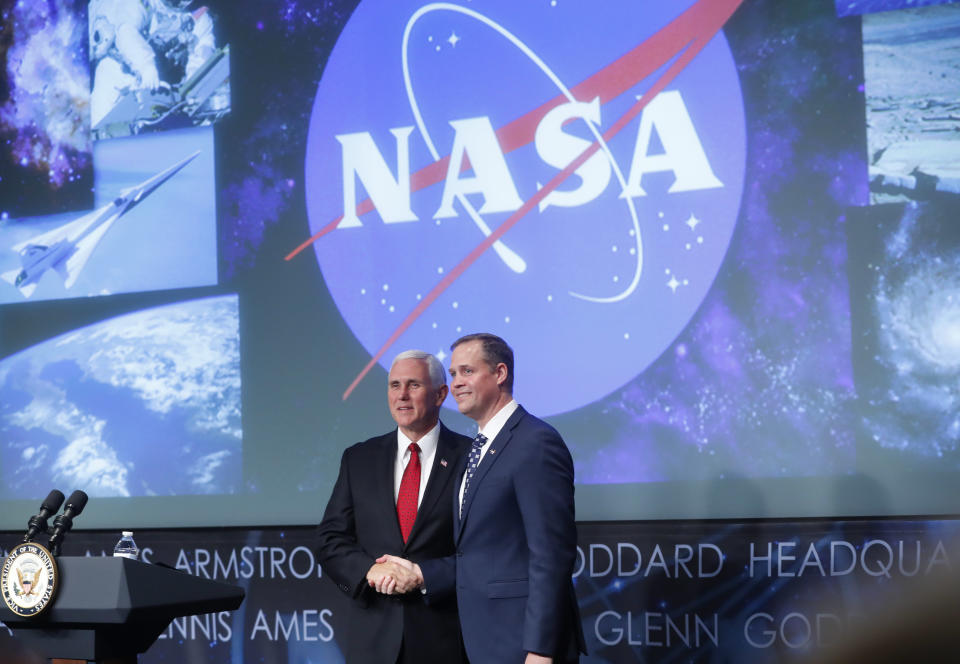
As Yahoo News reported last year, Trump’s overall space policy is to hand over most “low Earth orbit” missions to the private sector and have NASA focus on deep-space exploration. However, establishing a Space Force was the most talked-about proposal at the time of my NASA visit. Trump wants a sixth branch of the U.S. armed services that’s equal in stature to the Air Force.
“I think [Trump’s] instincts are correct. We’re seeing more threats in space than we’ve ever seen before,” Bridenstine said. “Space has become very contested. The president of course is probably getting those same briefs we got in Congress, and he wants to do something about it.”
Bridenstine said similar ideas have already been considered in Congress, namely a Space Corps that would have reported to the Secretary of the Air Force the way the Marine Corps reports to the Navy. That idea passed the House but not the Senate.
Although Space Force has been publicly mocked for sounding like something out of a Buck Rogers story, the United States is already engaged in protecting its interests in space — only right now Air Force Space Command and its Space and Missile Center are part of the Air Force. According to Bridenstine, it appears the president wants these parts of the Air Force to be placed under their own four-star general or admiral (depending on the service’s structure), who would sit on the Joint Chiefs of Staff and report to a separate service secretary. Therefore, Bridenstine said, it wouldn’t have to compete for funding with people responsible for the air domain.
“In the National Defense Authorization Act there was a Space Force. We called it a Space Corps. The president seems to want to call it a Space Force, which in my opinion he’s right. That at least sounds cooler,” Bridenstine said. “But I think this is an important concept and an idea whose time has come. As a member of the National Space Council, I look forward to working on that as a project.”
When asked whether he believes in extraterrestrial life, Bridenstine said, “As far as intelligent, I don’t know.” But he brought up NASA’s recent discoveries that affect the possibility of current or former life on Mars: methane cycles that track the planet’s seasons, evidence that three-quarters of its surface was once ocean, a magnetosphere that protects it from radiation and the solar winds and a thick atmosphere. All of those factors paint a picture of a planet that was habitable at one point.
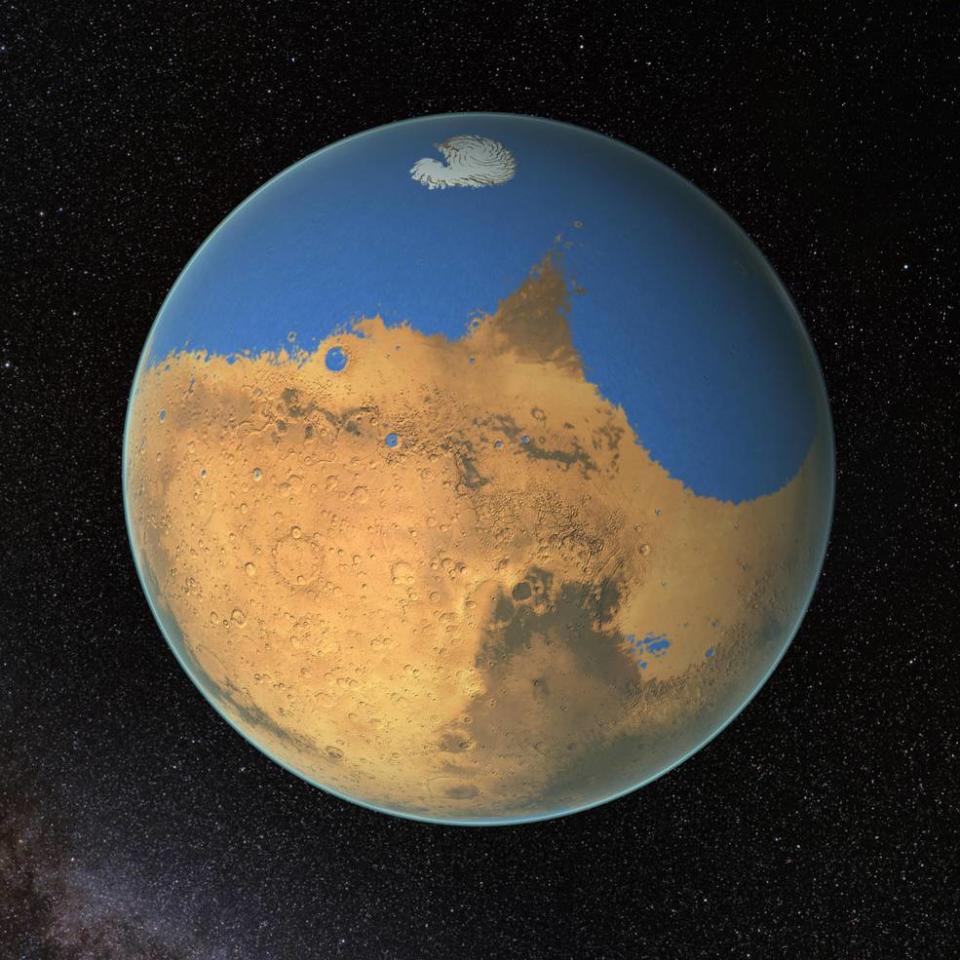
“I think it’s important for us as an agency to know if in fact life here on Earth is unique or if we are alone in the universe. I think that’s one of our missions, to look and discover if there’s life or was life not only in the universe but in our own solar system,” Bridenstine said. “But I’m certainly not going to try to give you probabilities.”
The news on Sept. 1, 2017, that Trump nominated Bridenstine — a congressman rather than a space industry professional — to lead NASA resulted in backlash and a drawn-out confirmation process. It took until April 19 for the Senate to confirm his appointment, in a narrow, party-line vote of 50 to 49.
Bridenstine, who served three terms in Congress as a Republican from Oklahoma, has served on the House’s Armed Services Committee and the Science, Space and Technology Committee. He was a naval aviator from 1998 until 2007 and served in the Naval Reserve from 2010 to 2015, primarily piloting an E-2C Hawkeye. He also directed the Tulsa Air and Space Museum & Planetarium but doesn’t have any formal degrees in science.
His supporters concede that Bridenstine doesn’t have the technical expertise of many previous administrators but don’t think that’s necessary for the role. After all, James E. Webb, the administrator during the glory days from 1961 to 1968, was a lawyer by training but became arguably the greatest director in NASA history.
“It’s not critical to have a deep knowledge of technology,” Hopkins said. “The more important thing is to have somebody who understands the importance of commercial space, and he’s very strong in that area. Also, backing from Congress won’t hurt either, because a lot of things a NASA administrator has to do is work with Congress.”

A major sticking point for Democrats early on were his statements on climate change. Sen. Brian Schatz, D-Hawaii, grilled Bridenstine during a November 2017 Senate hearing for failing to affirm that humans are the primary driver of climate change but thanked him during a May Senate hearing for listening to scientists and evolving on this issue.
When Yahoo News asked about his current stance on climate change, Bridenstine said, “Here’s what I know. Carbon dioxide is a greenhouse gas. We have increased its levels in the atmosphere significantly. Therefore, we have contributed to climate change.”
Bridenstine said he believes NASA scientists who have published reports saying humans are the primary cause of the warming we’re seeing: “We have some of the best scientists here at NASA, and they are sincere people, and I have no reason to doubt the study they put together.”
He took issue with the suggestion that climate change was a new issue for him. As former chairman of the House’s environmental subcommittee, he said he’s heard lots of testimony on this issue over the years. As a Navy veteran, he said he’s long known that the U.S. has to defend territory in the Arctic that it never had to before.
“So, we can stick our heads in the sand, but the Arctic is not what it used to be as far as the ice goes. We have to figure out as a country, how does our national security posture need to change based on those realities,” he said.
Sen. Bill Nelson, D-Fla., who as a NASA astronaut orbited the Earth aboard the space shuttle Columbia in 1986, led the Senate Democrats’ charge against Bridenstine’s confirmation — passionately arguing that he lacked the needed credentials. Yahoo News asked Nelson for his thoughts on Bridenstine’s first two months at NASA.
“Congressman Bridenstine is only just beginning to get his arms around the depth and breadth of the challenges involved in running NASA, and I sincerely hope for his success,” Nelson said. “I’m encouraged to see how his views on climate change have evolved, based on his exchange with Senator Schatz in a recent Senate hearing, and I’m also pleased that he is seeking to have a qualified space professional as his deputy.”
Some may be surprised to hear that for the 2018 fiscal year Trump approved the highest budget for NASA ($20.7 billion) since former President Barack Obama passed the economic stimulus package. The proposed 2019 fiscal-year budget for earth science, which includes climate change, has not yet been finalized but also looks very healthy.

“NASA is not a regulator. We don’t prescribe how to deal with the climate that’s changing,” Bridenstine said. “We collect the data and conduct the science and as far as I’ve ever seen, both Republicans and Democrats agree we have to know what’s happening to our planet.”
Rachel Licker, senior climate scientist at the Union of Concerned Scientists, told Yahoo News regarding Bridenstine, “We have been pleased with his recent statements of support for earth science and his acceptance of the scientific consensus on climate change. We are remaining deeply engaged to make sure he stays true to his commitment to keeping NASA’s work apolitical. And we are hopeful that things will remain on the right track.”
Rogue NASA on Facebook, one of the many “rogue” and “alt” accounts that emerged after Trump’s election, is simultaneously an advocate and a watchdog for NASA and the space industry. Like NASA Watch, the popular social media account’s mission is to inform the public and hold the administration accountable. An anonymous spokesman for Rogue NASA said, “There are literally thousands of people with better qualifications,” and added that the general mood among people watching Bridenstine closely is “one of cautious optimism with a bit of cynicism.”
“Bridenstine has done some things in his past as a politician that certainly raise eyebrows and are cause for concern, many of which involve topics he now is responsible for implementing at an agency or national level,” he told Yahoo News.
“The man who sits there now may be able to navigate the halls of Washington to effect positive change better than his predecessors, and that’s where the cautious optimism mentioned above comes in,” the Rogue NASA spokesman said.
LGBT advocates were among those skeptical of Bridenstine’s record in Congress, so he preemptively addressed concerns of bias during his first agency town hall on May 17: “As long as I’m at the helm of this agency, there will be no discrimination based on race, religion, sexual identity, sexual orientation, ethnicity, national origin or anything else.”
Despite the pointed headlines that greeted his nomination, Bridenstine has vowed to stay apolitical while leading NASA, building partnerships on both sides of the aisle and doing what’s best for the agency and the country. Will he keep his word? Only time will tell, but he’s been given a singular opportunity to do so.
Bridenstine’s favorite NASA mission is Apollo 8. It was the first time humans traveled to the moon and orbited around it. But the most striking image from that journey wasn’t the moon itself. It was Earth. The three Apollo 8 astronauts who transmitted a reading from the Book of Genesis on Christmas Eve 1968 while seeing the Earth as a whole for the first time is one of the most memorable moments in space history.
Only two months in, Bridenstine is still in the process of decorating his new office. During my visit, he was preparing to hang “Earthrise,” the famous photograph taken by Bill Anders during Apollo 8, near his desk. If politics are truly held in abeyance, maybe NASA will have more moments like this.
“In Washington, people like to put people in different groups and then create large divisions and say you’re on one side or the other,” Bridenstine said. “At NASA, I’m trying to bring everything together.”
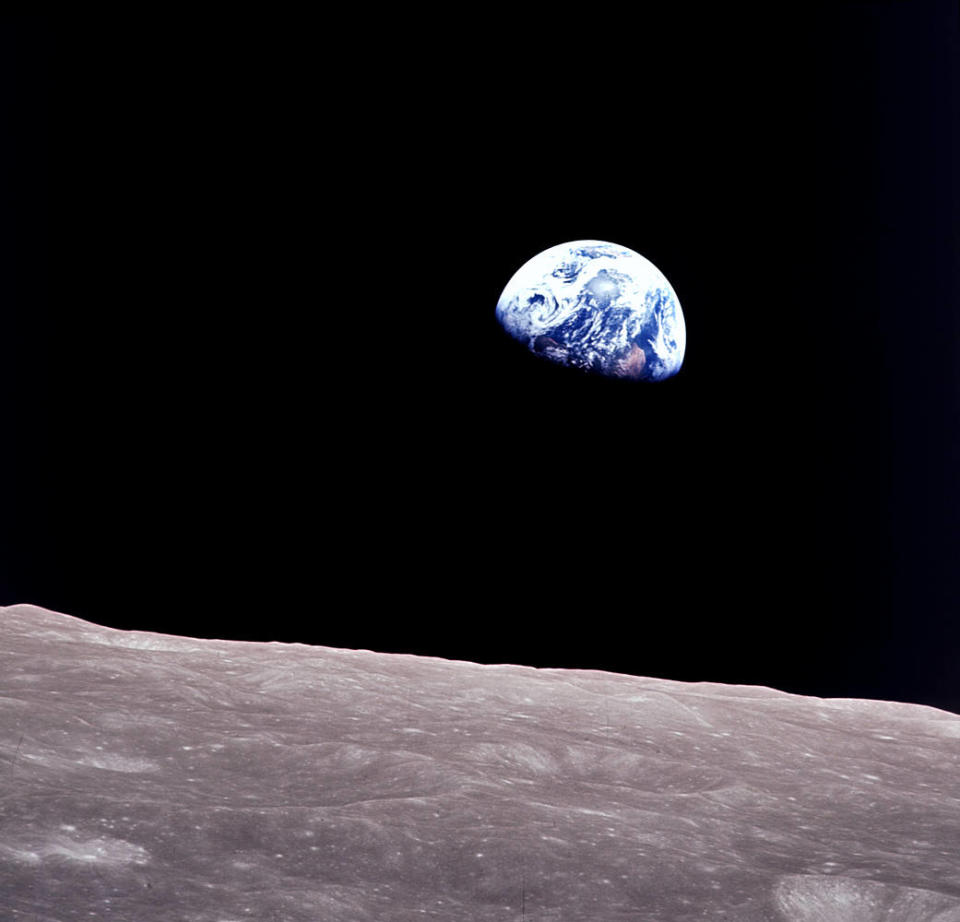
_____
Read more from Yahoo News:
Stephen Miller, meet your great-grandfather, who flunked his naturalization test
From the ‘Northern Triangle’ to the Rio Grande: Violence, poverty and disasters drive migration
Civility alert: Can’t we all just get along, or even get dinner?
With DACA phasing out, college graduates face an uncertain future
Photos: Court upholds Trump administration’s so-called travel ban


